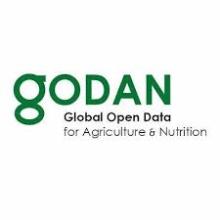Resource information
The GODAN Action online map of agri-food data standards is a deliverable of the GODAN Action project.
GODAN Action supports data users, producers and intermediaries to effectively engage with open data and maximise its potential for impact in the agriculture and nutrition sectors.
In particular, we work to strengthen capacity, to promote common standards and best practice and to improve how we measure impact.
The project is part of the GODAN programme that promotes the proactive sharing of open data to make information about agriculture and nutrition available, accessible and usable.
The project has been initially funded for 3.5 years by the UK Department for International Development.
Specifically, the map of data standards supports the GODAN Action task of mapping relevant standards and identifying areas where the lack of standards is inhibiting.
The objectives of this task are:
• To map currently available open and proprietary standards in use for the exchange of key data on agriculture and nutrition;
• To identify where a lack of standards is inhibiting the effective use of agricultural and nutritional data and the best methods for promoting open data standards.
The map of standards fulfills the first objective and is also designed to support the gap analysis exercise described in the second objective. The full report on the gap analysis is also available (Pesce, Kayumbi, Tennison, Mey and Zervas 2016).
Paraphrasing what the Dublin Core Metadata Initiative says about their DCMI Registry, this map promotes the wider adoption, standardisation and interoperability of agri-food vocabularies by facilitating their discovery and re-use across diverse communities of practice.
In addition, it provides a useful overview of what exists and helps to identify overlaps, duplication, gaps and limits to adoption, hopefully encouraging practitioners not to duplicate efforts and to collaborate both to develop and use common standards.
The first version of the map is available at http://vest.agrisemantics.org
This report is an accompanying document to the map of standards that describes the approach to the implementation of the map, the categorisation of standards, and gives an overview of the initial content.
It also gives details on the coverage and organisation of the map, and a summary of how we conducted a call to action to experts to contribute to its improvement.
Our approach to creating the map of standards was based on the principles of building on what already exists, providing for sustainability and defining standards in terms of use.
As the map is designed to support work on open data, we limited the scope to data standards, and chose not to include other types of standards. It is also important to clarify that while data standards may include the notion of data formats, we do not include mere data formats in the map (such as CSV, MDB, XML).
Within the scope of the map, by ‘data standards’ we mean ‘vocabularies’ without addition or qualification. This is the broad sense in which vocabularies are defined by W3C, which includes metadata element sets (schemas or definitions of description models, more in general ‘description vocabularies’) and value vocabularies (sets of controlled values).
This is why we use the terms ‘data standards’ and ‘vocabularies’ interchangeably, and they range from description/modelling standards (XML schemas, RDFS schemas, ontologies, application profiles, even UML models) to knowledge organisation systems of different types (classifications, thesauri, even certain types of International Organization of Standardization (ISO) standards as controlled lists of values).
The domains of food and agriculture span across several disciplines (including plant sciences, farming systems, natural resources management, forestry, all disciplines involved in the food supply chain), and are also closely interlinked with neighboring disciplines (such as climate, environment, geospatial, biology). We decided to include standards covering all of these disciplines.
In the standards map, we also included generic standards that are universally used to describe any resource (such as Dublin Core) or to describe or provide values for generic properties (geographic, ownership, provenance), as these are useful in any domain.


